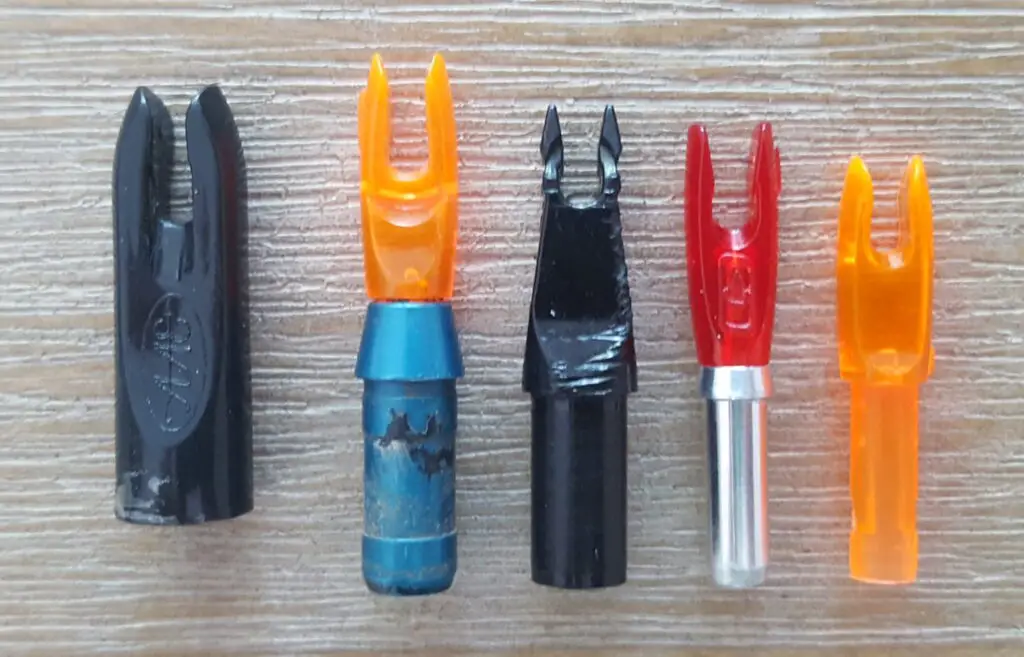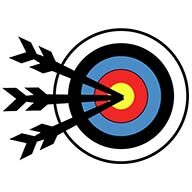Many people that are just getting started with archery think that every nock fits any string and any arrow. The truth could be farther from the truth. Every manufacturer has its own standards and there are many different fittings. Therefore, we will discuss in this article how you can navigate through these confusing standards and choose the right nock. If you don’t have the time to read this entire article, the information below will help you out:
To avoid issues with the nock fitting, it’s recommended to buy the nock and the arrow shaft from the same manufacturer. Target archers use thinner strings than traditional archers. Therefore, you should only buy strings that are clearly meant for target archery.
The anatomy of a nock
The nock might seem a very simple piece, but there are a few things that you should consider. In this section, we will discuss these aspects in more detail.
The fitting
Archers often talk about different nock types, which actually refers to the type of fitting. Not every nock fits every arrow, therefore you should always make sure that the nock can fit the arrow. In the next section, we will discuss the different nock fittings in more detail.
The mouth
The mouth is the part that slides over the string. When you nock the arrow, you often feel a click. This happens because the first part is narrower. This makes sure that the arrow stays firmly on the string.

The throat
When we discuss the throat of the nock, we mean the deepest part of the slit. This part of the slit is wider than the first part of the slit. This makes sure that the arrow doesn’t rotate with the string, which can influence the accuracy. We will discuss this in more detail in this section.
It is important to note, that the dimensions of the throat and the slit are not standardized between manufacturers. This means that some nocks might be too tight while others may not even retain the arrow. Therefore, it is important to find the correct nock size, which we discuss here.
The ridge
Most nocks don’t have this feature since it isn’t necessary. But some nocks have a little line on the side. This line is to make sure that you correctly nock the arrow. If you would nock the arrow the other way around, the vanes are likely to interfere with the bow. This can cause damage to vanes and decreases your accuracy. Most archers just learn how to nock the arrow, so I don’t think it’s very useful. But you now at least know where it for.
Different type of nock fittings
There are basically three types of nock fittings: press in, pin, fit over, and cone nocks. Sadly, only the press-in-nocks and pin nocks can work on the same type of arrow. We will discuss how these types of nocks work in more detail one by one.
| Type of nock fitting | Suitable for | Size(s) |
| Press-in-nocks | Most carbon and aluminum arrows for target archers | Varies, most common sizes:Small (3/16-inch, 4.5 cm)Large (1/4-inch, 6.2 cm) |
| Pin nocks | Most carbon and aluminum arrows for target archers | Varies, most common sizes:Small (3/16-inch, 4.5 cm)Large (1/4-inch, 6.2 cm) |
| Fit over nocks | Wooden arrows and some (cheaper) carbon arrows | Varies |
| Cone nocks | Aluminum arrows | Varies |
Press-in-nocks
The name already gives it away, you attach these nocks by pressing them in the arrow. Press-in-nocks are currently the most common nock type because they are simple to use and very inexpensive. You don’t need any glue to install the nocks since they are held in place by friction. You can, therefore, always easily change the nocks if you need to.
Although there are many different press-in-nock sizes available, the most common are 3/16 inch for thin arrows and 1/4 inch for thicker arrows. There are nocks available that are a little smaller or bigger, but they often still fit with arrows with one of these two sizes. But to be sure it’s often a good idea to buy the same brand nocks as arrows to avoid a misfit.

Pin nocks
The advantage of pin nocks is that they protect the arrow from ‘’Robin Hood’’ shots. Although it might be impressive the first time you split an arrow. When you are getting very accurate and when you are shooting more expensive shafts it becomes a major annoyance.
Therefore, when you shoot on your arrow which features a pin nock, the shaft of the arrow is often fine. You often only need to replace the plastic part of the nock and sometimes the insert. Therefore, archers that often experience split shafts often gravitate towards these nocks. Pin nocks are more expensive, however, so it isn’t really recommended for starting archers.
The size of the pin is standardized, meaning that any pin nock will fit any insert. The insert themselves, however, vary in similar vane as press-in-nocks.

Fit over nocks
Again, the name gives the idea behind this nock away. Fit over nock are not pressed into the shaft but over the shaft. These nocks are primarily used for shafts that cannot accept press-in-nocks, such as wooden arrows. Although these nocks are also present on some (cheap) carbon arrows, they are mostly used by traditional archers.

Cone nocks
The other nock types can damage aluminum arrows. Especially press-in-nocks and pin nocks might damage the arrow when fitted and used. Cone nocks are, therefore, only used for aluminum arrows. You will have to glue the nocks on to make sure that they won’t come off.
Build-in nocks
Only the cheapest arrows available use build-in nocks. These nocks are attached to the vanes and cannot easily be removed. Therefore, I would stay away from these nocks if you are a serious archer. Because you can’t exchange the nocks or vanes, you will have to throw the entire arrow away if anything happens to the arrow.

The correct nock size and fitting
The nock is an essential piece that attaches the string to the shaft. This means that there are two major things sizes that you must consider, the size of the fitting and the size of the throat.
Finding the correct nock fitting
Finding the right type of nock fitting isn’t difficult since all the different types have very distinct features. It’s a bummer, however, that manufacturers all use different sizes for their fittings and arrows. Although some fitting measurements are very popular, there is no standardization in the sizes.
The best way to avoid issues is to buy the shafts and the nocks from the same manufacturer. The manufacturer often has nocks that are recommended for each shaft. Going to the archery store and trying different nocks can also help. I would never buy nocks online if I am not familiar with the brand and the dimensions of the nock fitting. Because most retailers don’t place the actual specifications of the nock fitting on the product page, it’s very hard to judge whether the nock would even fit your shaft.

Finding the correct throat size
Your string and nock are often from different archery brands. Although some manufacturers produce both nocks and strings, most archers use third party strings. Either to save money or because they prefer a ‘’special’’ non-stretching string.
Finding the correct nock-string combination is very important as we discussed earlier. If the fit is not right, it can decrease your accuracy, but it can also be dangerous. Luckily, most manufacturers make very similar string sizes within target and traditional archery. See the table below for the measurements.
| Type of string | String thickness (excluding serving) | String thickness (including serving) |
| Target archery (compound and recurve) | 5/64 inch (2 mm) | 1/10 inch (2.5 mm) |
| Traditional archery | 1/10 inch (2.5 mm) | 1/8 inch (3 mm) |
There is still some variation within disciplines because it is very hard to closely replicate the exact thickness of a string. But in general, most target nocks will fit most target strings and most traditional nocks will fit most traditional strings. You will run into issues, however, if you try to mix and match between these disciplines.
Testing the nock size (throat and slit size)
Two simple tests allow you to test whether the throat and mouth of the nock are sized correctly to your string.
Method 1
- Nock the arrow with the nock you want to test.
- Keep the bow horizontally so that the arrow is pointing downwards. The arrow might dangle of the arrow rest, but that doesn’t matter for the test.
- The arrow should stay on the string while you point the arrow downwards. If the arrow falls off, the throat of the nock is too big. If the arrow stays on the string, go to the next step.
- Tap the string, without hitting the arrow. The arrow should fall of the string. It might take a few taps if you have a nock that is a bit tight. But if you can’t get it off by tapping the string, the throat is too heavy. If you are unsure whether the throat of your nock is to tight, try the second method.
Nock throat too tight
Nock throat loose enough
Method 2
- Nock the arrow with the nock you want to test.
- Keep the bow horizontally so that the arrow is pointing downwards. The arrow might dangle of the arrow rest, but that doesn’t matter for the test.
- Just like method 1, the arrow should not fall off the string when you point the arrow downwards. Otherwise, the throat of the nock is too big
- Gently turn the string and closely look at the arrow. The arrow should stay vertically and not move when you turn the string. If the arrow starts to move up, the throat of the nock is too tight.
Nock throat too tight
Nock throat loose enough
How the nock influences your accuracy
Although we briefly discussed it earlier in the article, I wanted to explain in more detail why it’s important to find the right nock. It can seriously influence the flight pattern of the arrow and, therefore, the accuracy of the bow.
Size of the throat
By far the most important aspect that can severely decrease the accuracy is the size of the throat. During the release, the string slightly rolls over your fingers, if the arrow grips the string to tight it will be influenced by this rolling motion. If we would release the string exactly the same way every time, we could account for this effect. But since it’s impossible to be 100% consistent, the arrow will be influenced differently between shots. Therefore, you should make sure that the throat and the mouth are not too tight, which you can test with the two methods above.
The firmness of the nock
The firmness of the throat determines how much effort it takes to get the nock from the string. Most strings have either a larger mouth made from stiff material or a small mouth made from a more flexible material. Some cheap Chinese nocks, however, have a small mouth made from stiff materials. This can cause the same issues as discussed before, that the rotation of the string influences the arrow.
Having a nock that grips the string too tight, also decreases the speed of the arrow. Because some of the power of the bow is transferred in pulling the nock from the string. In most cases, it won’t be noticeable, but in general, it’s important to note that more loose-fitting nocks are better for your accuracy. On the other hand, if the fitting of the nock is too loose, it might fall off your string unintentionally. This can cause dryfires and can be quite dangerous. Therefore, you should strike a balance between these two evils.
The weight of the nock
Although a nock doesn’t weight that much in comparison to the total arrow, the weight can still significantly influence the flight of the arrow. Just like how the weight of the point influences the dynamic spine, the weight of the nock also influences the dynamic spine, only in reverse. Let me explain how:
When the arrow has accelerated the point is of the arrow is more reluctant to move, because it is heavier than the rest of the arrow. Therefore, the arrow starts to flex. The flex is called the dynamic spine. Therefore, a heavier point will result in a more flex.
If you have a heavier nock it will be also more reluctant to move. Therefore, the nock will provide more resistance to the movement. This in turn pulls the arrow straight, resulting in less flex. A heavy nock will, therefore, decrease the dynamic spine.
In general, I wouldn’t worry too much about it, but if you have clearance issues, you might want to switch to either heavier points or lighter nocks, to increase the dynamic spine.
The length of the nock
Another thing that isn’t standardized is the length of the nock. I don’t mean the total length of the nock but how far the string is extended away from the arrow shaft. This in essence makes the arrow a bit longer. For most nocks, the measurement lies between ¼ of an inch (7 mm) and 5/10 of an inch (13 mm). Again, it wouldn’t dramatically influence the arrow, but especially if you switch from short to a very long nock, it will influence the dynamic spine.

Some final recommendations
You might be overwhelmed by the amount of variation and how much you need to consider when buying such a simple thing as a nock. Therefore, I have some simple recommendations to make choosing the right nock a whole lot easier:
- Buy the nocks and the shaft from the same manufacturer: to make sure that you don’t get a nock that doesn’t fit in your shaft.
- Only buy nocks and strings that are meant for your archery style: compound and recurve archers often use the same string thickness, but most traditional archers use thicker strings. Therefore, make sure that the type of string is made for target archery.
- If you are unsure whether the nocks fit your string, visit an archery shop before your purchase: once I have found the perfect fit, I never switched to another brand.
- Buy some spare nocks: when your shot technique improves, robin hood shots will become more common. In most cases, you only have to replace the nock to fix the arrow.
More buyer’s guides
Choosing the right archery gear is very important, therefore I have written a lot of buyer’s guides on all kinds of archery equipment. Learn more by clicking on any of the articles below.
Bows
Bow parts
Archery equipment
Final words
If you are assembling your own arrows, these two articles are worth a read:
Although nocks are not as simple as many people think. I believe with the recommendations above, purchasing nocks will be a whole lot easier. It’s especially not a good idea to buy the nocks from one manufacturer and the shafts from another. Since many things in archery and our general life are standardized, therefore we often assume nocks are too.
When I was writing this article, I still had to leave a lot of information out, because there is just a lot to explain. But I didn’t want to write a 5000-word article just about nocks. So, if you have any questions, issues, or ideas, please leave them down below. I will respond to your question as soon as possible and you will receive an email with my response.
Tim van Rooijen
For as long as I can remember, I have always been fascinated by archery. First due to its historic significance but later because I like being outdoors. With this blog, I share my knowledge about Archery and how you can improve your shot. More about author…


Great guide on arrow nocks.
Great to hear that you found my article helpful!
I bought a home made cross bow at an estate sale, I think I have the nock part down so I can select the right one for the string or new buy and new string and nock to match thank to your article. My ? is about the bolt is there a standard for how far the tip is to extend passed the front end of the stock or bow part of a cross bow? Thank you. Byron
Hi Byron, before I answer your question I have to tell you that I am not really experienced with crossbows. But for as far as I know there are no set rules on how far the tip should extend past the front end.
That doesn’t mean that you can’t put any length of bolt on your crossbow. Specifically, because this will also influence the dynamic spine of the arrow which influences the bolt’s flight, as I explain in this article (https://improveyourarchery.com/spine-weight-what-it-is-and-why-it-matters/). But that is mainly a concern if your crossbow needs to be extremely accurate.
Therefore, I wouldn’t worry about the length of the arrow too much. Crossbows tend to be much more forgiving than traditional bows in this regard. Some retailers recommend certain bolts for certain draw weight or crossbow models, which can also be helpful.
I hope this answers your question!